We’d like to remind Forumites to please avoid political debate on the Forum.
This is to keep it a safe and useful space for MoneySaving discussions. Threads that are – or become – political in nature may be removed in line with the Forum’s rules. Thank you for your understanding.
The MSE Forum Team would like to wish you all a very Happy New Year. However, we know this time of year can be difficult for some. If you're struggling during the festive period, here's a list of organisations that might be able to help
📨 Have you signed up to the Forum's new Email Digest yet? Get a selection of trending threads sent straight to your inbox daily, weekly or monthly!
Has MSE helped you to save or reclaim money this year? Share your 2025 MoneySaving success stories!
Green, ethical, energy issues in the news
Comments
-
Talking of home batteries - the subsidy scheme in Australia, launced a month ago, has been a massive success. You can get ~30% off for installs of 5kWh to 50kWh (and on the first 50kWh of installs up to 100kWh).
Storage is particularly important in Aus, where they have greater annual PV generation, and far better year round generation too. So the high penetration of demand side PV (now over 30% I believe) works well with storage, to help decarbonize the evening leccy demand.Australia’s surge in household battery installations is ‘off the charts’ as government subsidy program powers up
A federal government program that gives a 30% subsidy on home batteries has sparked an “off the charts” surge in installations, with more than 11,500 applications to the scheme in its first three weeks.
Industry analysts said the battery boom was reminiscent of the surge in rooftop solar 15 years ago, and that it was ushering in a second revolution in home electricity.
According to data provided to Guardian Australia by the Clean Energy Regulator (CER), 11,536 batteries have been installed since the government’s $2.3bn Cheaper Home Batteries program opened for connections on 1 July. More than 1,000 batteries were being installed every day.
The managing director of solar consultancy SunWiz, Warwick Johnston, said on some days more battery systems had been registered than stand-alone solar systems – a first for Australia.
“Before the scheme was announced, there were about 75,000 battery installations in 2024 compared to 300,000 solar PV systems. So to go from one in six, to one [for] one, shows this [program] has unleashed a wave of interest,” he said.Mart. Cardiff. 8.72 kWp PV systems (2.12 SSW 4.6 ESE & 2.0 WNW). 28kWh battery storage. Two A2A units for cleaner heating. Two BEV's for cleaner driving.
For general PV advice please see the PV FAQ thread on the Green & Ethical Board.2 -
michaels said:29.8p per kwh? What has the import cost you?It's a net metering tariff so import and export are the same, 22.3p day rate and 29.8p at peak rate (4-7pm). In summer we do not import anything at peak rate as solar covers our usage, and we will export 10.8kWh from battery plus any excess solar during the peak.
That's an EV tariff (other than E.On Next Drive) and we don't have an EV so is not an option for us, but lets look at the maths. On an average day in summer we may use 10kWh and generate 30kWh.NigeWick said:
How about if you import 23:30 - 05:30 at 7p per kWh, use the battery throughout the day and export all your solar at 15p per kWh? Obviously, doing all your washing, dishwashing etc at that 7p per kWh?My spreadsheet modelling tells me no other tariff can get close to IOF in summer where we are large net exporters,If we purchase 10kWh at 7p (£70p) to charge battery/run the house all day and then export all the solar at 15p SEG (£4.50), our net profit is £3.80/day.If we purchase 10kWh at 22.3p (£2.23) and export 10kWh during peak (£2.98) and the remaining 20kWh at day rate (£4.46), our net profit is £5.21 which comfortably beats the EV tariff.Being a net metering tariff, it's profitable whenever you are a net exporter (and costs whenever you are a net importer). I predict we are net exporters for 6 months of the year with the switchover points around the beginning of April and October, depending how sunny/cold it is (we have an ASHP so usage is higher if heating is on). We will switch to Octopus Cosy in winter where usage could rise to 40-50kWh/day (again an EV type tariff costs more as the battery is not big enough to last the day and may be empty by 2pm in the middle of winter). We should be net zero, both in terms of generation/usage and cost over the course of a year.Our green credentials: 12kW Samsung ASHP for heating, 7.2kWp Solar (South facing), Tesla Powerwall 3 (13.5kWh), Net exporter3 -
Not questioning your maths, but the "EV" tariffs aren't strictly just for those with EVs. I'm on Octopus Go and don't have an EV. EON explicitly state their equivalent is for those with an EV *or* battery.NedS said:michaels said:29.8p per kwh? What has the import cost you?It's a net metering tariff so import and export are the same, 22.3p day rate and 29.8p at peak rate (4-7pm). In summer we do not import anything at peak rate as solar covers our usage, and we will export 10.8kWh from battery plus any excess solar during the peak.
That's an EV tariff (other than E.On Next Drive) and we don't have an EV so is not an option for us, but lets look at the maths. On an average day in summer we may use 10kWh and generate 30kWh.NigeWick said:
How about if you import 23:30 - 05:30 at 7p per kWh, use the battery throughout the day and export all your solar at 15p per kWh? Obviously, doing all your washing, dishwashing etc at that 7p per kWh?My spreadsheet modelling tells me no other tariff can get close to IOF in summer where we are large net exporters,If we purchase 10kWh at 7p (£70p) to charge battery/run the house all day and then export all the solar at 15p SEG (£4.50), our net profit is £3.80/day.If we purchase 10kWh at 22.3p (£2.23) and export 10kWh during peak (£2.98) and the remaining 20kWh at day rate (£4.46), our net profit is £5.21 which comfortably beats the EV tariff.Being a net metering tariff, it's profitable whenever you are a net exporter (and costs whenever you are a net importer). I predict we are net exporters for 6 months of the year with the switchover points around the beginning of April and October, depending how sunny/cold it is (we have an ASHP so usage is higher if heating is on). We will switch to Octopus Cosy in winter where usage could rise to 40-50kWh/day (again an EV type tariff costs more as the battery is not big enough to last the day and may be empty by 2pm in the middle of winter). We should be net zero, both in terms of generation/usage and cost over the course of a year.Solar install June 2022, Bath
4.8 kW array, Growatt SPH5000 inverter, 1x Seplos Mason 280L V3 battery 15.2 kWh.
SSW roof. ~22° pitch, BISF house. 12 x 400W Hyundai panels1 -
Battery storage seems like a no brainer in Australia. I wonder what this will do for the average home's grid import/export? Bearing in mind a) Australia is obviously sunnier than the UK, but much more varied in terms of climate, b) air conditioning use is much higher and c) Australia has the largest average house size in the world, and most are single storey which gives a lot of roof space (though I noticed that there is an unusual preference for hips rather than gables, which eats into usable space).Martyn1981 said:Talking of home batteries - the subsidy scheme in Australia, launced a month ago, has been a massive success. You can get ~30% off for installs of 5kWh to 50kWh (and on the first 50kWh of installs up to 100kWh).
Storage is particularly important in Aus, where they have greater annual PV generation, and far better year round generation too. So the high penetration of demand side PV (now over 30% I believe) works well with storage, to help decarbonize the evening leccy demand.Australia’s surge in household battery installations is ‘off the charts’ as government subsidy program powers up
A federal government program that gives a 30% subsidy on home batteries has sparked an “off the charts” surge in installations, with more than 11,500 applications to the scheme in its first three weeks.
Industry analysts said the battery boom was reminiscent of the surge in rooftop solar 15 years ago, and that it was ushering in a second revolution in home electricity.
According to data provided to Guardian Australia by the Clean Energy Regulator (CER), 11,536 batteries have been installed since the government’s $2.3bn Cheaper Home Batteries program opened for connections on 1 July. More than 1,000 batteries were being installed every day.
The managing director of solar consultancy SunWiz, Warwick Johnston, said on some days more battery systems had been registered than stand-alone solar systems – a first for Australia.
“Before the scheme was announced, there were about 75,000 battery installations in 2024 compared to 300,000 solar PV systems. So to go from one in six, to one [for] one, shows this [program] has unleashed a wave of interest,” he said.
Average rooftop array size was 8.74 kW in 2022, though this was skewed slightly larger by small commercial systems. % of homes with PV varied from 25% in the Northern Territory to 53% in South Australia (figures from Solar Panel Install Statistics and Facts in Australia - Solar Calculator). I was a little surprised that the NT was in last place because it is by far the hottest of the states/territories so air conditioning demand must be highest so potential savings greatest.
Here's a PVGIS estimate for 8 kW in Darwin. It's close enough to the equator that the overcast summer and clear winter have a bigger impact than day length and sun angle so generation is higher in winter than summer, but the variation isn't that big.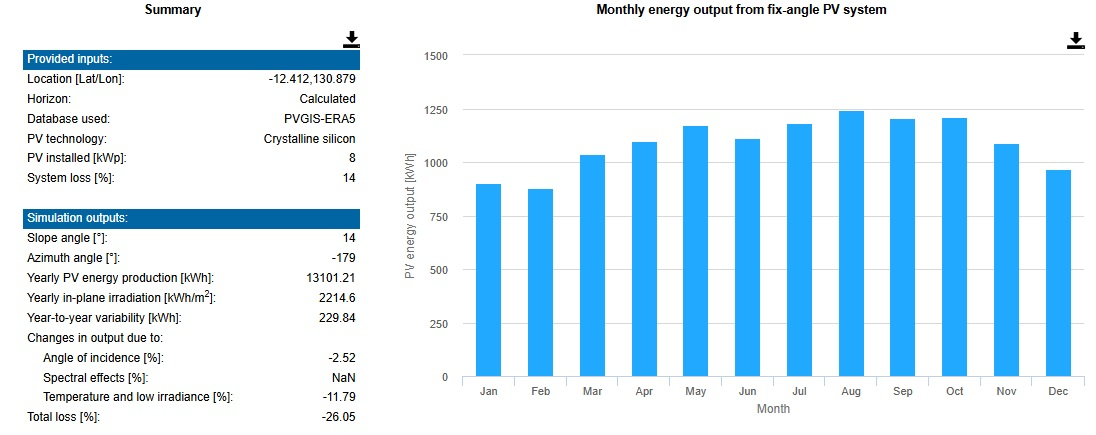
And an idea of seasonal air conditioning demand, average temps don't vary that much, but relative humidity and overnight temps do: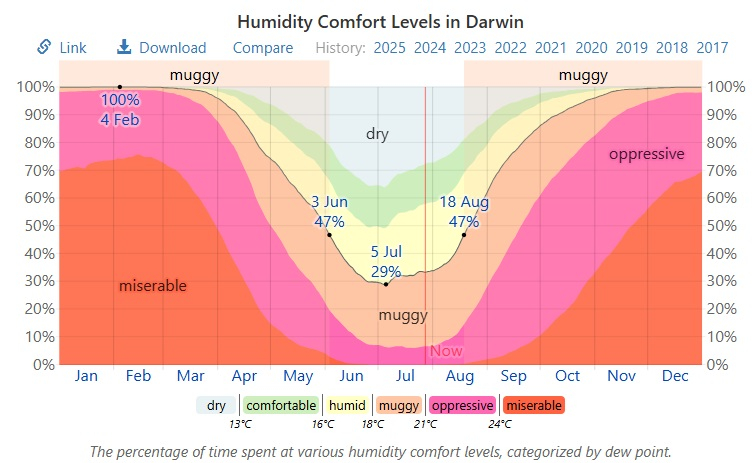
Adelaide in South Australia: much further from the equator and has much more overcast winters than summers so the opposite generation pattern to Darwin: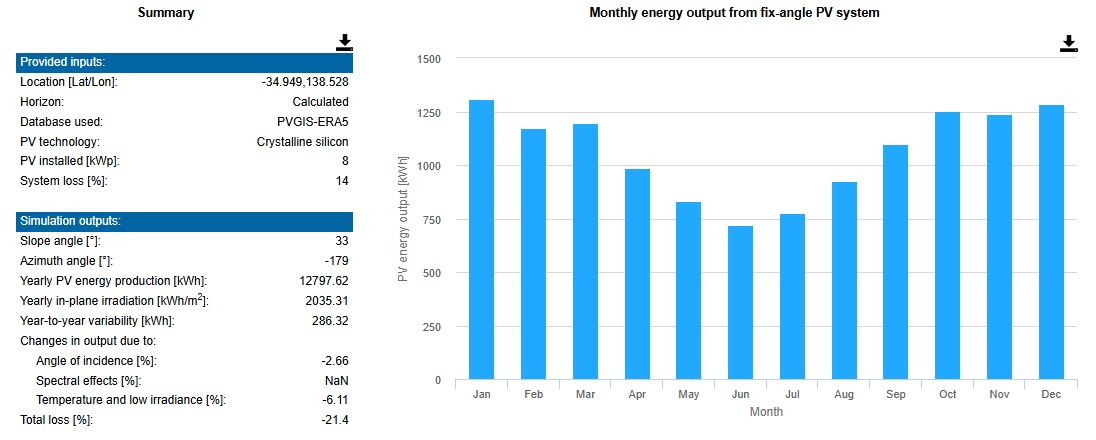
Average temperatures seem relatively mild with some AC and heating demand: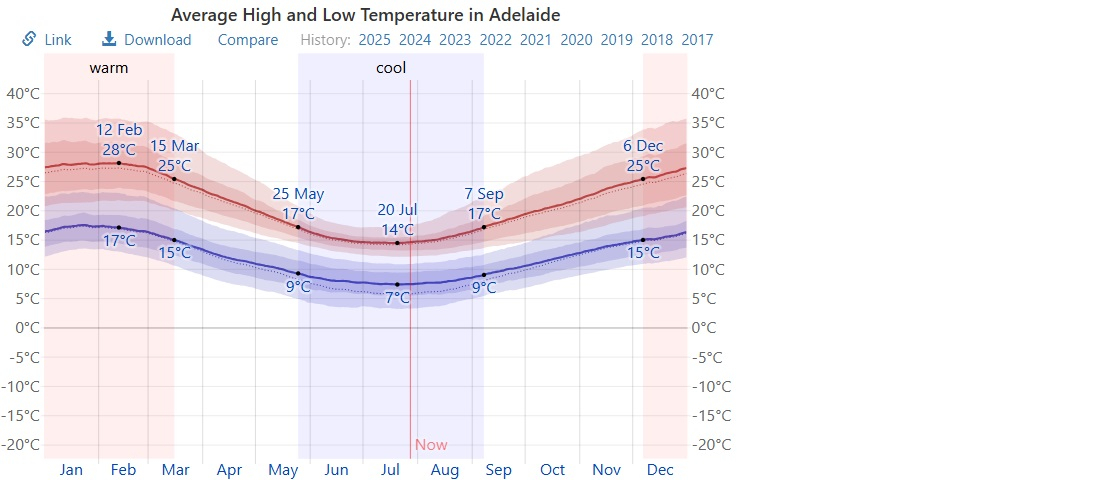
But if you look at the Bureau of Meteorology data (I like the way they give 1st and 9th decile temps) you can see temps are actually very variable with 10% of days exceeding 30C from Nov to March and 10% of days in the hottest month (Jan) exceeding 36.6C.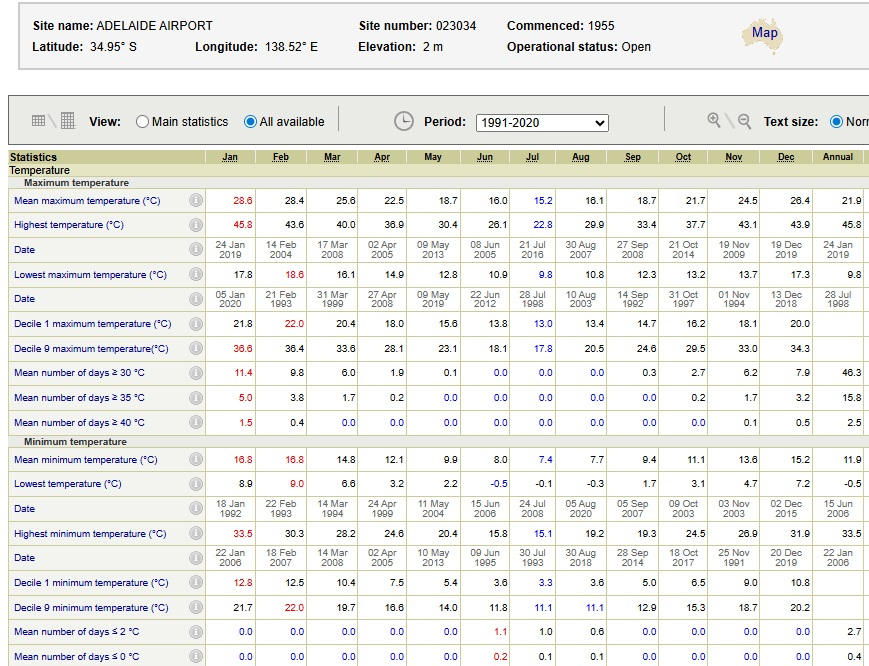 Solar install June 2022, Bath
Solar install June 2022, Bath
4.8 kW array, Growatt SPH5000 inverter, 1x Seplos Mason 280L V3 battery 15.2 kWh.
SSW roof. ~22° pitch, BISF house. 12 x 400W Hyundai panels1 -
Last time I checked the Octopus GO terms it was a requirement to have an EV. I think when they first launched the tariff they were more flexible. I do know of someone who had a protracted argument with Octopus when they applied for GO with house batteries and were denied. Things may have changed since then though.ed110220 said:
Not questioning your maths, but the "EV" tariffs aren't strictly just for those with EVs. I'm on Octopus Go and don't have an EV. EON explicitly state their equivalent is for those with an EV *or* battery.Install 28th Nov 15, 3.3kW, (11x300LG), SolarEdge, SW. W Yorks.
Install 2: Sept 19, 600W SSE
Solax 6.3kWh battery2 -
NedS said:QrizB said:Exiled_Tyke said:This got me thinking about the future of TOU tariffs, growth of EV use and whether it will become viable for the electricity companies to control more of our households than just the EV charger. If they could run the heating (particularly hot water) and may be even some appliances then I wonder how much curtailment could be taken out as well as emergency peak usage of non-RE production.If it was priced right, I'd be happy to fit a smart switch controlled by Octopus to my HW tank immersion heater to let them control my HW heating (much like they do my EV and IOG).It would need to be closer to £50, though, rather than the £900 I paid for the EV charger!I've handed my battery over to Octopus as part of their IOF tariff. The App shows I'm part of a 1080 property VPP, and the other evening we were contributing ~6MW to the grid between us (interestingly, this figure only appears to include the forced export from the battery, not the excess solar that I'd naturally be exporting anyway).Octopus discharge my battery daily during the 4-7pm peak down to it's 20% reserve to support peak grid demand, and pay me 29.8p for the privilege. The battery then sits at it's 20% reserve until the following day where it recharges during the middle of the day helping to mop up all that summer excess solar. Octopus can change the regime around daily to support the grid as required.My spreadsheet modelling tells me no other tariff can get close to IOF in summer where we are large net exporters, so to be able to help balance the grid in this way rather than just dump huge amounts of excess solar on the grid during the middle of the day when it's least needed seems like a win-win to me.
Where do it show your VPP details in the app?
0 -
All I can say is that I emailed to switch to Go and they did it without asking about an EV. Perhaps a case of don't ask a question that will trigger the answer that you don't want? Ie if you ask "can I have Go without an EV but with batteries?" they'll say "no", but if if you just ask "please switch me to Go" they'll say "Of course". This was in late Jan this year. Last time I checked, EON said it was for those with an EV or battery. Their rates are better than Octopus, but I haven't switched because I'm not sure that the savings will be worth the potential losses in the switchover.Exiled_Tyke said:
Last time I checked the Octopus GO terms it was a requirement to have an EV. I think when they first launched the tariff they were more flexible. I do know of someone who had a protracted argument with Octopus when they applied for GO with house batteries and were denied. Things may have changed since then though.ed110220 said:
Not questioning your maths, but the "EV" tariffs aren't strictly just for those with EVs. I'm on Octopus Go and don't have an EV. EON explicitly state their equivalent is for those with an EV *or* battery.Solar install June 2022, Bath
4.8 kW array, Growatt SPH5000 inverter, 1x Seplos Mason 280L V3 battery 15.2 kWh.
SSW roof. ~22° pitch, BISF house. 12 x 400W Hyundai panels0 -
From Octopus website : "Octopus Go is designed for customers who either own or have a long-term lease of a battery electric vehicle or a plug-in hybrid vehicle that they will be charging at their home that we supply"Exiled_Tyke said:
Last time I checked the Octopus GO terms it was a requirement to have an EV. I think when they first launched the tariff they were more flexible. I do know of someone who had a protracted argument with Octopus when they applied for GO with house batteries and were denied. Things may have changed since then though.ed110220 said:
Not questioning your maths, but the "EV" tariffs aren't strictly just for those with EVs. I'm on Octopus Go and don't have an EV. EON explicitly state their equivalent is for those with an EV *or* battery.NE Derbyshire.4kWp S Facing 17.5deg slope (dormer roof).24kWh of Pylontech batteries with Lux controller BEV : Hyundai Ioniq51 -
"Designed for" isn't the same as a requirement though. Economy 7 was designed for night storage heaters but it's not a requirement to have night storage heaters to be on a tariff like this.EricMears said:
From Octopus website : "Octopus Go is designed for customers who either own or have a long-term lease of a battery electric vehicle or a plug-in hybrid vehicle that they will be charging at their home that we supply"Exiled_Tyke said:
Last time I checked the Octopus GO terms it was a requirement to have an EV. I think when they first launched the tariff they were more flexible. I do know of someone who had a protracted argument with Octopus when they applied for GO with house batteries and were denied. Things may have changed since then though.ed110220 said:
Not questioning your maths, but the "EV" tariffs aren't strictly just for those with EVs. I'm on Octopus Go and don't have an EV. EON explicitly state their equivalent is for those with an EV *or* battery.Solar install June 2022, Bath
4.8 kW array, Growatt SPH5000 inverter, 1x Seplos Mason 280L V3 battery 15.2 kWh.
SSW roof. ~22° pitch, BISF house. 12 x 400W Hyundai panels0 -
Latest version of Eon next drive specifically only available for those with EV which has caused much consternation.ed110220 said:
Not questioning your maths, but the "EV" tariffs aren't strictly just for those with EVs. I'm on Octopus Go and don't have an EV. EON explicitly state their equivalent is for those with an EV *or* battery.NedS said:michaels said:29.8p per kwh? What has the import cost you?It's a net metering tariff so import and export are the same, 22.3p day rate and 29.8p at peak rate (4-7pm). In summer we do not import anything at peak rate as solar covers our usage, and we will export 10.8kWh from battery plus any excess solar during the peak.
That's an EV tariff (other than E.On Next Drive) and we don't have an EV so is not an option for us, but lets look at the maths. On an average day in summer we may use 10kWh and generate 30kWh.NigeWick said:
How about if you import 23:30 - 05:30 at 7p per kWh, use the battery throughout the day and export all your solar at 15p per kWh? Obviously, doing all your washing, dishwashing etc at that 7p per kWh?My spreadsheet modelling tells me no other tariff can get close to IOF in summer where we are large net exporters,If we purchase 10kWh at 7p (£70p) to charge battery/run the house all day and then export all the solar at 15p SEG (£4.50), our net profit is £3.80/day.If we purchase 10kWh at 22.3p (£2.23) and export 10kWh during peak (£2.98) and the remaining 20kWh at day rate (£4.46), our net profit is £5.21 which comfortably beats the EV tariff.Being a net metering tariff, it's profitable whenever you are a net exporter (and costs whenever you are a net importer). I predict we are net exporters for 6 months of the year with the switchover points around the beginning of April and October, depending how sunny/cold it is (we have an ASHP so usage is higher if heating is on). We will switch to Octopus Cosy in winter where usage could rise to 40-50kWh/day (again an EV type tariff costs more as the battery is not big enough to last the day and may be empty by 2pm in the middle of winter). We should be net zero, both in terms of generation/usage and cost over the course of a year.
Utility Warehouse is probably the only cheap night tariff that does not need an EV as per the T&CsI think....0
Confirm your email address to Create Threads and Reply

Categories
- All Categories
- 353K Banking & Borrowing
- 253.9K Reduce Debt & Boost Income
- 454.8K Spending & Discounts
- 246K Work, Benefits & Business
- 602.1K Mortgages, Homes & Bills
- 177.8K Life & Family
- 260K Travel & Transport
- 1.5M Hobbies & Leisure
- 16K Discuss & Feedback
- 37.7K Read-Only Boards






